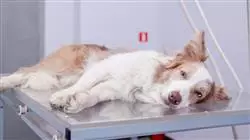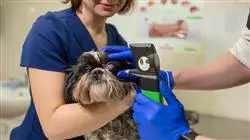University certificate
The world's largest faculty of veterinary medicine”
Description
Acquire in a safe way, with a high-quality study, the knowledge required for the first approach to neurological pathologies affecting small animals"

This course deals with the embryology, anatomy and physiology of the nervous system. For a correct understanding of the pathologies that cause alterations in the nervous system, it is essential to know how the structures that compose it are formed embryologically, to see which are its components and how they function and interrelate with each other.
The study of embryology and the process of the Training of the nervous structures in the embryo is fundamental for the knowledge of congenital pathologies that have their explanation in the bad development of the embryo.
It is important to know the bony structures that protect the central nervous system of the different regions of the brain and spinal cord, which are key to a correct interpretation of the imaging tests. As well as the exhaustive knowledge of the essential anatomy focuses the practitioner on the surgical procedures and in the approach and techniques that neurosurgery demands.
Arterial and venous vascularization and its presence and disposition in the central nervous system are studied, essential knowledge to know the pathologies that can cause vascular accidents (hemorrhage, infarction), as well as their intraoperative management and the techniques of the different approaches.
The neurological examination consists of several parts and we must be methodical in its performance in order not to miss any data that may have a relevant importance in our assessment of the problem. One part will be patient observation (mental status, gait and posture) and the other part will be a practical examination, which will include the evaluation of cranial pairs, postural reactions and spinal reflexes.
The neurological examination will indicate the place or places in the nervous system where the problem is located (neurolocalization), and in each part of the nervous system there is a series of characteristic clinical signs that we will detail in this topic.
Depending on where the problem is located: in the central nervous system or in the peripheral nervous system, the clinical and diagnostic tests will be very different, being very important its recognition to reach definitive conclusions.
It addresses how to correctly perform a neurological examination, the collection of data such as anamnesis and review, a correct physical examination of the patient and a methodical and systemic evaluation of the neurological examination. The emphasis will also be placed on everything necessary to carry it out and collect the data.
You will learn how to perform a methodical and efficient neurological examination that will provide you with the first keys to action, guiding your approach in the most efficient and safe way”
This postgraduate certificate in Neurological Examination and Localization in Small Animals offers the characteristics of a program of high scientific, teaching and technological level. These are some of its most notable features:
- The latest technology in online teaching software
- A highly visual teaching system, supported by graphic and schematic contents that are easy to assimilate and understand
- Practical cases presented by practising experts
- State-of-the-art interactive video systems
- Teaching supported by telepractice
- Continuous updating and recycling systems
- Autonomous learning: full compatibility with other occupations
- Practical exercises for self-evaluation and learning verification
- Support groups and educational synergies: questions to the expert, debate and knowledge forums
- Communication with the teacher and individual reflection work
- Content that is accessible from any fixed or portable device with an Internet connection
- Supplementary documentation databases are permanently available, even after the course
Un estA study that includes knowledge of the anatomy and physiology of the nervous system, brain or spinal cord"
The topics and clinical cases proposed, as well as their resolution, are based on the practical experience of the teachers and on the latest advances in research and development that nurture this field of work.
All knowledge is presented through high quality multimedia content, analysis of clinical cases prepared by the teachers, master classes and video techniques that allow the exchange of knowledge and experience, maintain and update the level training of its members, create protocols for action and disseminate the most important developments in emergency medicine in small animal medicine.
TECH teaching staff is made up of professionals from different fields related to this specialty. In this way TECH makes sure to offer the student the instructional update objective it intends. A multidisciplinary team of communication management trained and experienced in different environments, who will develop the theoretical knowledge in an efficient way, but, above all, will bring their practical knowledge derived from their own experience to the course: one of the differential qualities of this training.
This mastery of the subject matter is complemented by the effectiveness of the methodological design of postgraduate certificate. Developed by a multidisciplinary team of e-learning experts, it integrates the latest advances in educational technology. This way, you will be able to study with a range of comfortable and versatile multimedia tools that will give you the operability you need in your training
The design of this program is based on Problem-Based Learning: an approach that conceives learning as a highly practical process. To achieve this remotely, we will use telepractice learning: with the help of an innovative interactive video system, and learning from an expert, you will be able to acquire the knowledge as if you were actually dealing with the scenario you are learning about. A concept that will allow you to integrate and fix learning in a more realistic and permanent way..

Learn at your own pace, in a process that combines intensity and flexibility to allow you to learn in a comfortable and sustainable way"
Objectives
A complete review the most current knowledge in terms of scientific research and technological development in diagnostic techniques and intervention in neurological pathologies in small animals. The objective is to generate specialized knowledge in the student, creating a well-structured basis to identify the clinical signs associated with each neurological location and to be able to establish a list of differential diagnoses, acting correctly to achieve the best possible prognosis in patients.

Grow in your professional competencies by incorporating into your practice the diagnostic and treatment capabilities of the latest techniques in veterinary medicine in this field”
General Objectives
- Examine the embryonic development of the nervous system in its different phases and the mechanisms involved in its training
- Determine, in an exhaustive manner, the different regions of the central nervous system, peripheral nervous system and musculoskeletal system
- Analyze the physiology and mechanism of the functioning of the central nervous system
- Identify the different vascular structures of clinical importance to identify possible vascular pathologies and learn about these structures in surgical procedures
- Perform a correct anamnesis and data collection
- Determine the steps of the neurological examination and its correct performance
- Identify the characteristic clinical signs depending on the site of the lesion
- Define the list of problems depending on the patient’s course, clinical history and review
Specific Objectives
Module 1. Embryology, Anatomy, Physiology Of The Nervous System
- Identify the different stages of embryonic development of the nervous system
- Present, in a clear and concise manner, the anatomy and physiology of the brain and the anatomy and physiology of the spinal cord
- Develop the mechanisms of nerve impulse transmission
- Determine the different bones and joints that protect the brain and spinal cord
- Examine the characteristics of the arterial and venous blood supply to the brain and spinal cord
Module 2. Neurological Examination and Neurolocalization
- Structure the steps to follow for a correct neurological evaluation
- Analyze the different differential diagnoses depending on each case
- Identify the characteristic clinical signs of a lesion in the forebrain, brainstem and cerebellum
- Identify the clinical signs characteristic of a lesion in the different segments of the spinal cord and of a peripheral nervous system involvement

Providing better care in the field of neurology will result in the growth of quality care for your patients that today's pet owners demand"
Postgraduate Certificate in Small Animal Neurological Examination and Localization
.
If you are passionate about veterinary medicine and want to specialize in the neurological field, TECH Global University's Postgraduate Certificate in Small Animal Neurological Examination and Localization is the opportunity you've been waiting for. Our program offers 100% high quality online classes, which means you can access the content from the comfort of your home or any place with an internet connection. With flexible schedules and the ability to learn at your own pace, you won't have to give up your daily responsibilities to expand your knowledge in the area of veterinary neurology. In the Postgraduate Certificate in Small Animal Neurological Examination and Localization, you will immerse yourself in the fascinating world of veterinary neurology. You will learn the most up-to-date techniques and methodologies for performing a thorough neurological examination in dogs and cats, identifying the characteristic clinical signs of different neurological diseases and disorders.
Get passionate about veterinary medicine specialization with these interesting topics.
Our program is designed to provide you with a comprehensive advanced progression in the localization of neurological lesions in small animals. You will learn how to interpret the results of diagnostic tests such as MRI, CT and EEG, and apply the best therapeutic strategies to improve the quality of life of your patients. With TECH you will have a team of highly qualified professionals with extensive experience in the field of veterinary medicine. They will guide you in your learning process, providing you with practical tools and fundamental theoretical knowledge to become an expert in the neurological examination and localization of lesions in small animals. Don't miss this opportunity to expand your skills and excel in the field of veterinary neurology. Participate in our Postgraduate Certificate in Small Animal Neurological Examination and Localization and get ready to make a difference in the health and well-being of the animals you love so much.







